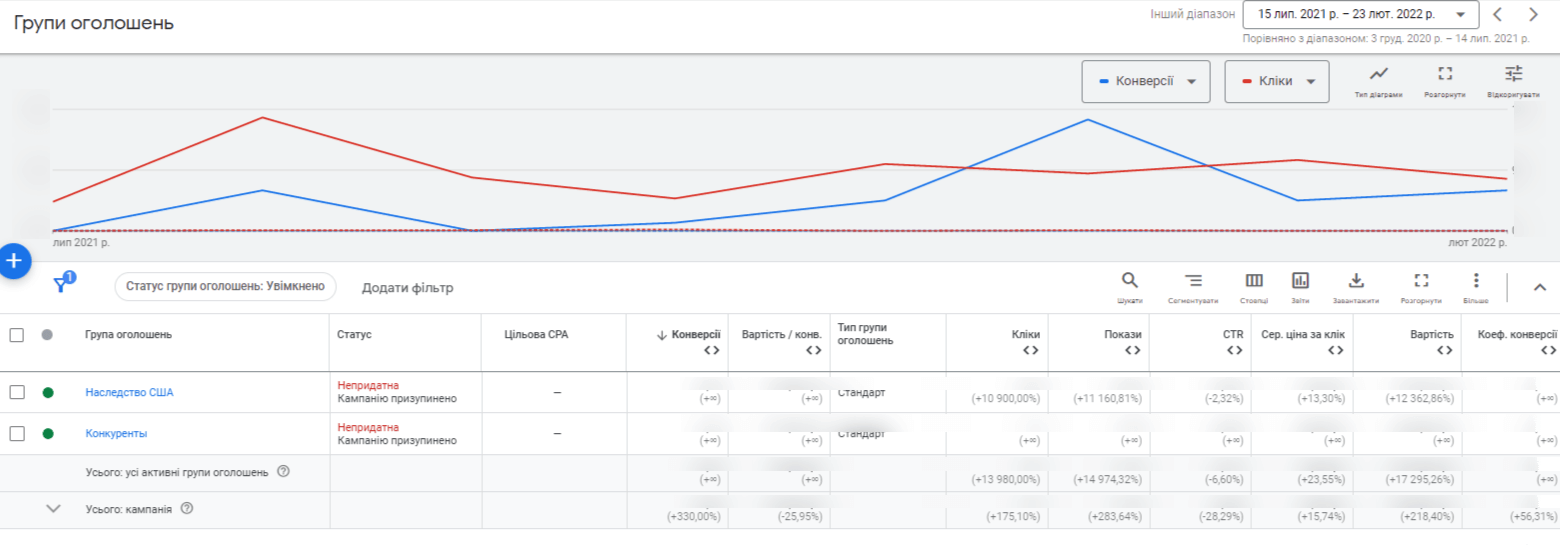Client
An international law firm with a license to provide law services in the United States and Ukraine, working in several legal areas: inheritance, real estate, family law, international law, immigration to the United States, and corporate law. The firm had representative offices in the U.S. and Ukraine.
Period of work
Active work on the project was conducted from June 2019 to February 2022, with interruptions at the client’s request.
Our task
To get targeted traffic to the site.
Preamble
The highest priority for the client is inheritance cases. The peculiarity of this direction is that the company deals with inheritance cases in the U.S. and assists in the inheritance cases to foreigners in America. Since such a service is quite specific, there are few relevant frequency keywords in the search network.
Advertising campaign in the search network
Initially, when launching advertising campaigns in the search, advertising was set up for several priority areas of legal services, but since August 2019 at the client’s request all areas of services, except inheritance cases, were turned off.
Due to the fact that there is little frequency semantics in Google for this area, we:
- expanded the semantics with keywords with broader meaning to reach users at an earlier stage of readiness to submit an application;
- launched keywords in English;
- launched an advertising campaign with dynamic search ads to increase traffic to the site and show ads for low-frequency search queries.
Still, these actions did not have the desired effect, because the keywords also had low frequency or were too broad. Therefore, as a result of the effectiveness analysis, we have suspended the ineffective keywords. The screenshot below shows the period of expansion of semantics:
A campaign with dynamic search ads failed to launch due to poor site optimization: the system was unable to identify topics and keywords for targeting on landing pages.
This type of ads uses content-based targeting and works best when the page titles are properly crafted and the content is clear to the system.
From the Google Ads Help: Dynamic search ads are shown for queries on Google that are closely related to your site’s content (headlines and frequently used phrases).
In July 2021, we changed the advertising campaign structure from SKAG (1 group — 1 keyword) to STAG (1 group — 1 topic) to collect more ad group statistics and improve the efficiency of the smart bidding strategy.
SKAG grouping (1 group — 1 keyword) was previously used to maximize the relevance of the ad to the keyword through its inclusion in the text. When using the SKAG structure, because of the large number of groups, the total traffic for the ad campaign was too fragmented. When grouping by STAG type (1 group — 1 topic), we slightly lose in the relevance of ads to the search query, but we get more benefit due to the collection of more statistics by groups of ads and more effective training of automatic strategies, and can use the keys in a broad match type. Google has improved this type of match and now keywords in a broad match type work effectively in conjunction with smart bidding (taking into account other keywords in the group, landing page, user location, and other signals).
After some time, after collecting statistics, we launched keyword testing in a broad match type, resulting in:
- an increase in the number of ad shows;
- increase in traffic to the site from search engines;
- increase in the number of irrelevant search queries which we analyzed and excluded on a daily basis.
As a result of daily study of search queries and suspension of ineffective keywords, we were able to increase the relevance of traffic, increase the number of advertising campaign conversions by more than 4 times and reduce their cost by a quarter.
Advertising campaign in the contextual media network
The service being advertised is quite specific, so it is important to reach users at different stages of the sales funnel. For this purpose, we launched:
- a contextual media advertising campaign targeting specific audiences by intent in order to increase traffic to the site and reach users at earlier stages of readiness to buy;
- a remarketing campaign to bring back users who have visited the site and are in the later stages of their path to purchase.
To customize specific audiences by intent, we used search queries related to inheritance processing abroad and in the U.S., as well as informational queries related to inheritance in the U.S.
By using machine learning and smart bidding strategies for an advertising campaign, the contextual media network finds relevant traffic and gets conversions even in such a narrowly targeted niche as an inheritance service in America.
After launching an advertising campaign in the contextual media network, traffic to the site increased more than 25 times, and the share of conversions received in the contextual media network was more than 45%.
Results
As a result of running ads in the search engine based on keywords in a broad match type and running ads in the contextual media network, at the end of the optimization period, we were able to increase relevant traffic to the site by 66%, the number of macro conversions (sending forms on the site and clicks on the number) — more than 3 times, and the cost of conversion was reduced by 55.6%.




